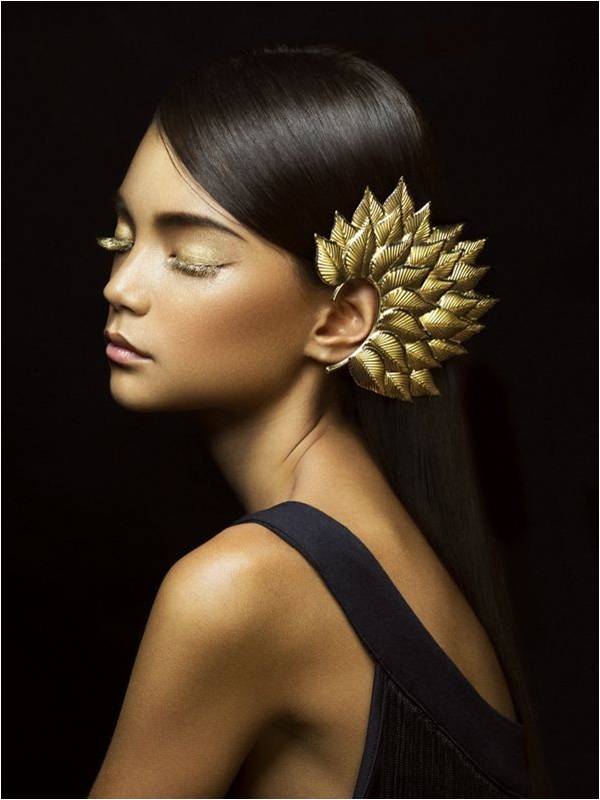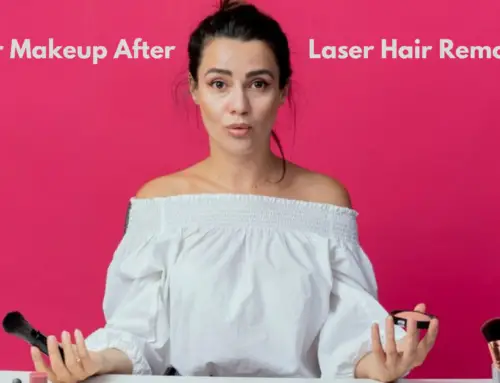When it comes to fashion and beauty, editorial makeup has the power to transform a simple look into something extraordinary. It is a creative and artistic form of makeup application that pushes the boundaries of traditional beauty standards and allows for self-expression. With its bold colors, imaginative designs, and avant-garde techniques, editorial makeup is like a work of art on the face, leaving a lasting impression on the viewer.
Editorial makeup has a rich history rooted in the world of fashion and photography. It emerged as a way to elevate the visual impact of editorial shoots and runway shows. Unlike everyday makeup, which is designed to enhance natural features, editorial makeup is all about experimentation and pushing the limits. It allows makeup artists to showcase their skill and creativity, often incorporating unconventional elements like glitter, feathers, and even non-traditional textures. With its ability to evoke emotion and tell stories, editorial makeup has become an integral part of the fashion industry, capturing the attention of both professionals and enthusiasts alike.
Editorial makeup is a creative form of makeup artistry typically used for fashion shows, photo shoots, and magazine editorials. It allows makeup artists to push boundaries and experiment with unconventional looks, using bold colors, textures, and techniques. Unlike everyday or natural makeup, editorial makeup is about making a statement and evoking emotions. It often involves dramatic eye makeup, avant-garde designs, and unique application methods. Editorial makeup artists have a deep understanding of color theory, composition, and storytelling, creating visual masterpieces that transcend traditional beauty norms.

Unleashing Artistic Expression: The Magic of Editorial Makeup
Editorial makeup is a form of artistic expression that goes beyond traditional beauty looks. It is a transformative and imaginative style of makeup that pushes the boundaries of creativity. From bold colors and avant-garde designs to unconventional textures and techniques, editorial makeup allows artists to tell a story, convey a message, and create visually stunning images. In this article, we will delve into the world of editorial makeup, exploring its purpose, techniques, and impact in the fashion and beauty industry.
Exploring the Purpose of Editorial Makeup
The purpose of editorial makeup is to evoke emotions, challenge norms, and inspire viewers. Unlike everyday or natural makeup looks, which are designed to enhance one’s features, editorial makeup focuses on creating a visual spectacle and pushing the boundaries of conventional beauty standards. It is often used in editorial photo shoots, fashion shows, and avant-garde productions to create striking images that captivate and provoke thought.
Techniques and Elements of Editorial Makeup
Editorial makeup artists utilize a wide range of techniques and elements to bring their creative visions to life. Some of the key elements of editorial makeup include:
- Color: Bold, vibrant colors are often used in editorial makeup to create eye-catching looks and convey emotions. Whether it’s neon hues, metallic shades, or contrasting color combinations, the use of color is an essential aspect of editorial makeup.
- Texture: Editorial makeup often incorporates unconventional textures, such as glitter, sequins, or feathers, to add dimension and interest to the look. These textures can be applied to various areas of the face or body for a dramatic effect.
- Prosthetics: In some cases, editorial makeup may involve the use of prosthetics to alter the appearance of the face or create fantasy-inspired characters. Prosthetics can be used to create intricate designs, exaggerated features, or otherworldly creatures.
- Graphic Shapes: Geometric shapes, graphic lines, and abstract designs are commonly used in editorial makeup to create visually striking compositions. These elements can be incorporated into eye makeup, lip art, or overall face and body designs.
The Impact of Editorial Makeup in the Fashion and Beauty Industry
Editorial makeup plays a significant role in the fashion and beauty industry. It has the power to challenge beauty standards, spark trends, and inspire creativity. By pushing the boundaries of traditional makeup, editorial looks often pave the way for new techniques, products, and artistic styles. It serves as a platform for makeup artists to showcase their skills and create iconic images that leave a lasting impact on the industry.
Editorial Makeup vs. Everyday Makeup
While editorial makeup is all about pushing boundaries and creating art, everyday makeup focuses on enhancing one’s natural features for a more subtle and wearable look. Everyday makeup is typically more subdued in terms of colors, texture, and techniques. It is designed to enhance natural beauty and provide a polished appearance for everyday activities.
Tips for Creating Editorial Makeup Looks
If you’re inspired to experiment with editorial makeup, here are some tips to get you started:
- Research and gather inspiration: Look for inspiration in fashion magazines, editorials, and online platforms to gather ideas for your makeup looks. Pay attention to different techniques, colors, and elements used in editorial makeup.
- Experiment with colors and textures: Don’t be afraid to play with bold colors and textures that are not typically used in everyday makeup. Experiment and have fun with different shades and finishes.
- Practice and refine your skills: Building your skills is crucial in creating editorial makeup looks. Practice different techniques, blend colors, and work on perfecting your precision.
- Collaborate with photographers and models: Work with photographers and models to bring your editorial concepts to life. Collaborating with other creative professionals can elevate your work and create stunning imagery.
Pushing the Boundaries of Creativity: The Future of Editorial Makeup
As the world of beauty and fashion continues to evolve, so does the realm of editorial makeup. With the rise of social media and digital platforms, editorial looks have become more accessible to a wider audience. Artists are using these platforms to showcase their work, collaborate with brands, and inspire others around the world. The future of editorial makeup holds endless possibilities for innovation, inclusivity, and creative expression.
Conclusion
Editorial makeup is a form of artistic expression that takes makeup to new heights. It allows artists to unleash their creativity, tell stories, and challenge traditional beauty norms. With its use of bold colors, textures, and innovative techniques, editorial makeup creates visually stunning images that captivate and inspire. Whether you’re an aspiring makeup artist or a lover of beauty and art, exploring the world of editorial makeup can be a transformative and exhilarating journey.
Key Takeaways: What is Editorial Makeup?
- Editorial makeup is a type of makeup that is used for fashion photoshoots, magazine covers, and runway shows.
- It is often more creative and artistic than everyday makeup, with bold colors, unique textures, and avant-garde designs.
- Editorial makeup is meant to tell a story and evoke emotions, showcasing the vision of the makeup artist and the overall concept of the shoot.
- It requires advanced techniques and skills, as well as a deep understanding of color theory and makeup trends.
- Editorial makeup can push boundaries and challenge traditional beauty standards, making it a highly exciting and transformative form of art.
Frequently Asked Questions
Editorial makeup is a unique and creative form of makeup artistry that is commonly seen in fashion magazines, photo shoots, and runway shows. It is a style of makeup that pushes boundaries, embraces artistic expression, and tells a story through the use of colors, textures, and unconventional techniques.
1. How is editorial makeup different from everyday makeup?
Editorial makeup is different from everyday makeup in several ways. Firstly, editorial makeup is more experimental and creative, often using bold and unconventional colors and techniques. It is meant to make a statement and create a visual impact. On the other hand, everyday makeup is usually more natural and subtle, focusing on enhancing features and creating a polished look for everyday wear.
Secondly, editorial makeup is often used in fashion and editorial photography, where the goal is to create visually stunning and eye-catching images. Everyday makeup, however, is more suitable for everyday activities and aims to enhance natural beauty without overpowering the overall look.
2. What are some common elements of editorial makeup?
Editorial makeup often includes elements such as bold and vibrant colors, graphic shapes and lines, intricate detailing, and unconventional textures. It may also involve the use of embellishments, props, or special effects to create a specific theme or concept. The purpose is to create a visually striking and captivating look that evokes emotions and tells a story.
In addition to these elements, editorial makeup artists also focus on flawless skin, precise application, and attention to detail. The use of high-quality and professional-grade makeup products is crucial to achieve the desired effect.
3. Who wears editorial makeup?
Editorial makeup is primarily worn by models, celebrities, and individuals involved in the fashion and entertainment industry. It is commonly seen in fashion magazines, editorial photo shoots, runway shows, and other artistic platforms where visual impact and creativity are highly valued.
However, editorial makeup can also inspire and influence everyday makeup looks. Elements and techniques used in editorial makeup often trickle down into mainstream beauty trends, allowing individuals to incorporate elements of editorial makeup into their own personal style.
4. What skills are required to create editorial makeup looks?
Creating editorial makeup looks requires a combination of technical skills, artistic creativity, and a strong understanding of color theory and makeup techniques. Knowledge of different makeup products, tools, and their application is essential. Makeup artists also need to be able to interpret and execute creative concepts and collaborate with photographers, stylists, and other members of the creative team.
It is important for makeup artists to stay updated with the latest trends and be open to experimentation and pushing boundaries. Flexibility and adaptability are key, as editorial makeup often requires quick thinking and improvisation during photo shoots or runway shows.
5. How can I learn more about editorial makeup?
If you’re interested in learning more about editorial makeup, there are several resources available. You can consider attending makeup artistry courses or workshops that specifically focus on editorial makeup techniques. These classes often provide hands-on training and guidance from experienced professionals in the industry.
In addition, you can explore online tutorials, books, and magazines that feature editorial makeup looks and provide step-by-step instructions. Following established makeup artists and industry influencers on social media platforms can also give you insights into the latest trends and techniques in editorial makeup.
talk through tutorial | editorial makeup look
Editorial makeup is a type of makeup that is specifically designed for editorial photoshoots, fashion shows, and magazine spreads. It is characterized by its bold and artistic approach, allowing makeup artists to experiment with unique and creative looks.
Unlike everyday makeup, editorial makeup is not meant to be worn on a daily basis. It is often used to convey a specific concept or tell a story that matches the theme of the shoot or editorial. It involves the use of vibrant colors, dramatic techniques, and exaggerated features to create visually impactful looks.






Leave A Comment